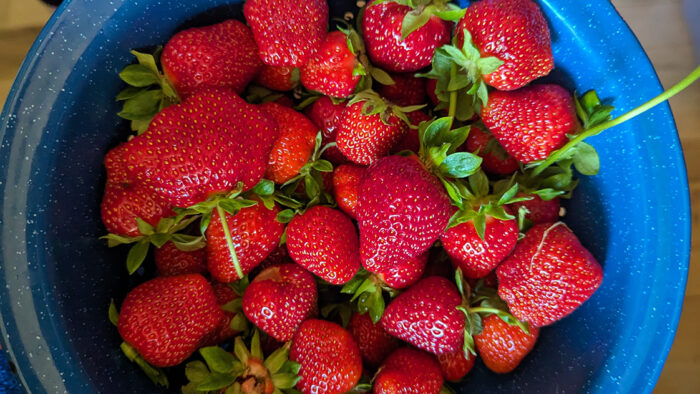How to Grow Strawberries
Learn the basics to succeed with strawberries

We all know that the fresh goodness of strawberries is well worth a little trouble. Not only is the sugar-berry flavor of strawberries a delicious reward, but they’re also a pretty easy crop to grow in your garden and will become even easier the following year.
What strawberries want
Strawberries adore basking in the full sun in well-drained, sandy-loam soil. If you live in a very windy area, be sure to plant them in an area where they’ll be somewhat protected. They like a soil pH of about 6.0 to 6.5 if you’re into that sort of thing. (I’m not, but some people like to know.)
How to plant strawberries
You can plant strawberries in their permanent spot as soon as the soil becomes warm enough in your zone to do so. For West Coast gardeners, this can be as early as late winter.
Before I plant my strawberries, I simply hand-till 3 to 4 inches of compost into the bed or container. Strawberries don’t like to dry out, but wet feet will cause them to get crown rot, so water them in moderation.
When you plant your little strawberry plants, dig a hole and make a little mound in the middle. Then gently spread out the roots and set the plant on the mound—think about straddling a horse. When you fill in the hole, you’re looking to make sure the soil line is at the middle of the crown. If you plant them too deeply, you set them up for crown rot; too shallow, and the roots become exposed and the plant dies.
Three common types of strawberries
June-bearers—These plants don’t fruit until one year after they’re planted.
Ever-bearers—These produce a nice crop of berries late in the summer after planting.
Day neutrals—These perform basically the same as the ever-bearers but can produce berries from midsummer to fall in the same year.
Botrytis—a common strawberry problem
A little annoyance that sometimes creeps up on you (and the strawberries) is a fungus called botrytis. It creates a horrid-looking coat so furry that it could send up a flag for any nearby animal-rights activists. The fungal spores generally come from the old leaves that are on the soil. Botrytis can also grow in organic soil, and when you water it hits the soil and splashes back up onto the strawberry blossoms. If you put down 1 to 2 inches of composted mulch, it will keep the spores from reaching the plant.
How to harvest strawberries
Don’t pull on the berry to harvest it from the plant. Instead, pinch it off at the stem so you don’t ruin the fruit. Try to harvest all of the ripe or overripe berries; this will help reduce problems with disease.
Fine Gardening Recommended Products

A.M. Leonard Deluxe Soil Knife & Leather Sheath Combo
Fine Gardening receives a commission for items purchased through links on this site, including Amazon Associates and other affiliate advertising programs.

Corona E-Grip Trowel
Fine Gardening receives a commission for items purchased through links on this site, including Amazon Associates and other affiliate advertising programs.

Lee Valley Garden Obelisks
Fine Gardening receives a commission for items purchased through links on this site, including Amazon Associates and other affiliate advertising programs.






Comments
Log in or create an account to post a comment.
Sign up Log in